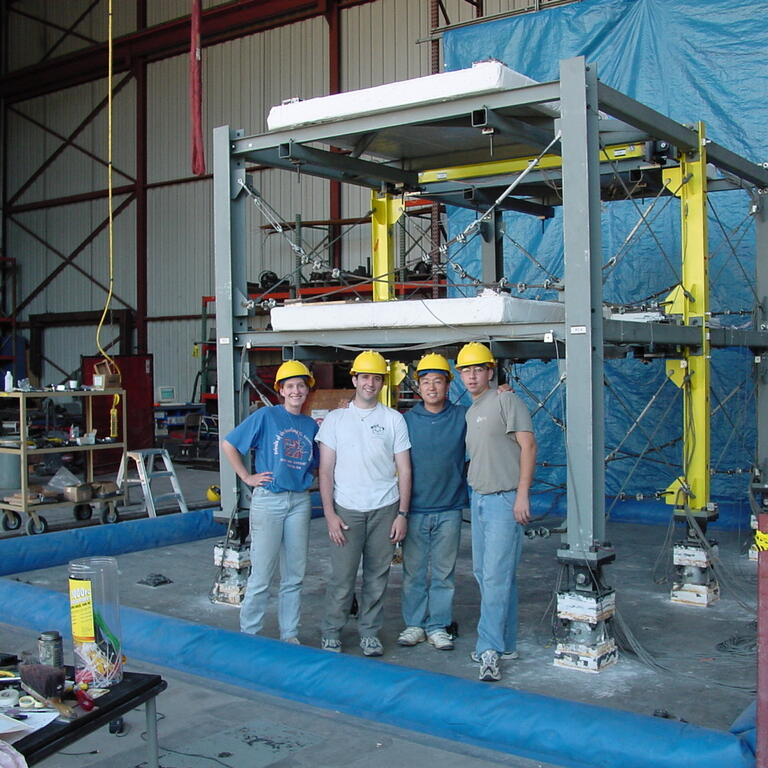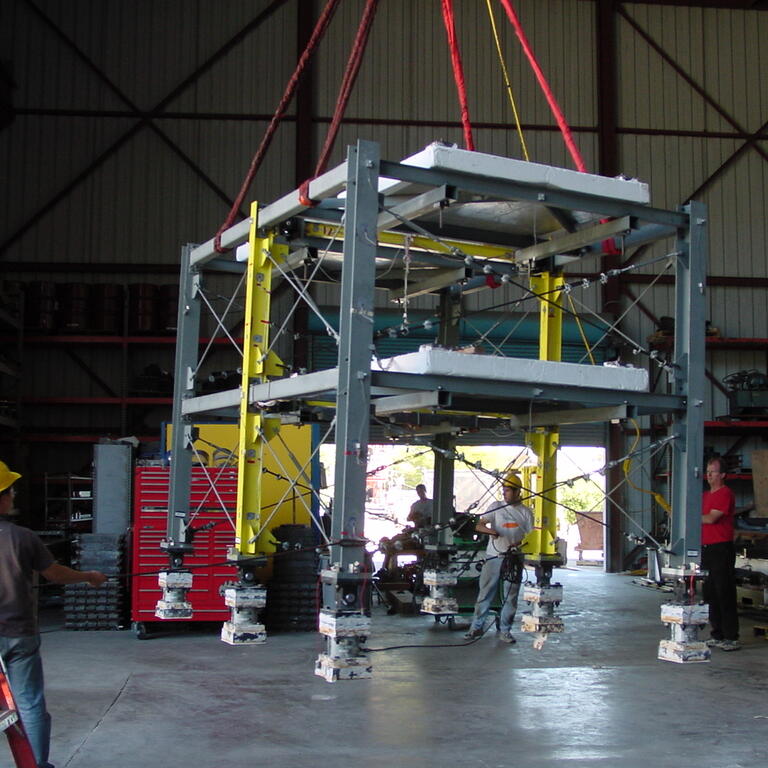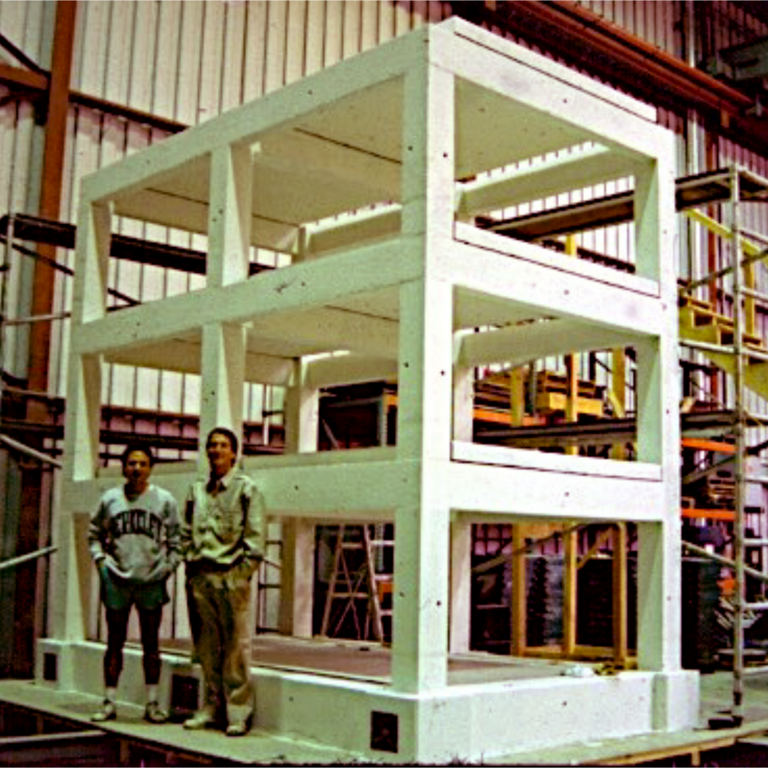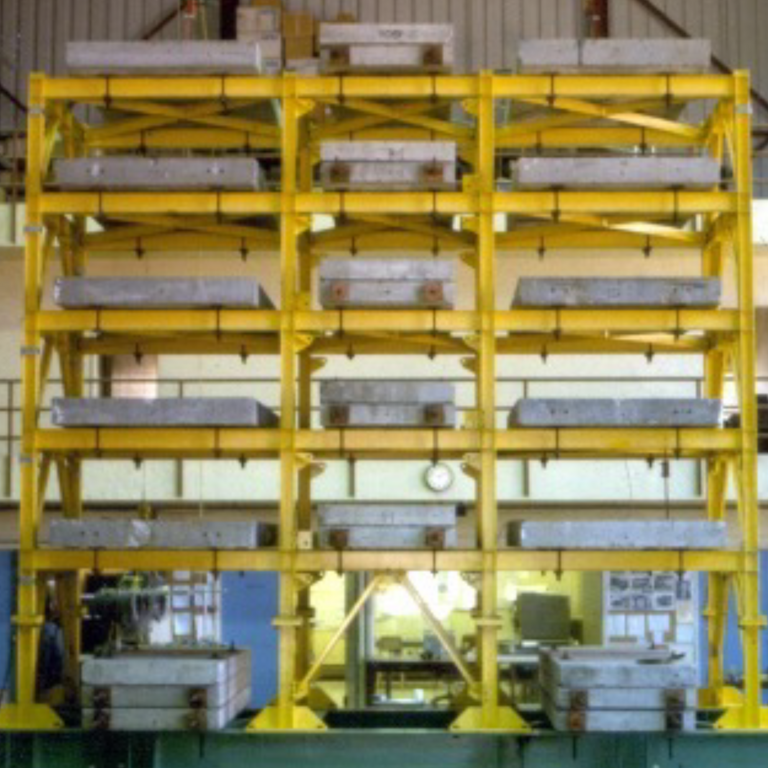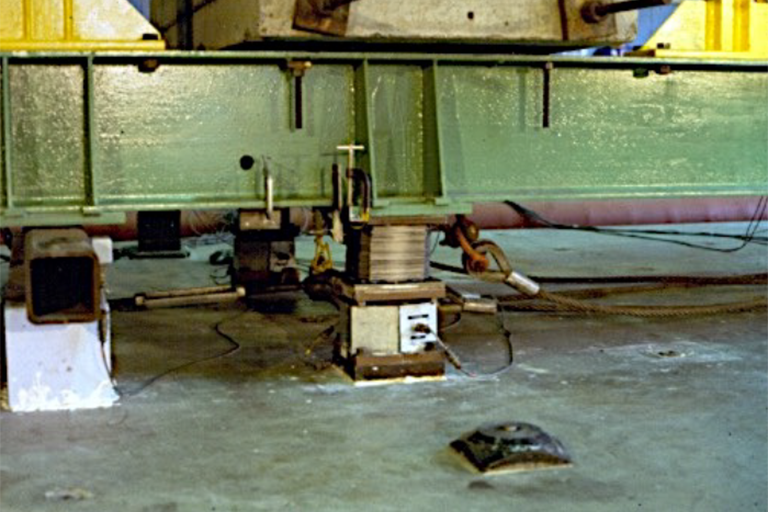
"Prof. Vitelmo Bertero, 83 years old, supervising a shaking table test during one of my visits to Berkeley in 2006" - Raul Bertero, University of Buenos Aires
 Stephen Mahin, PEER Director, 2009–2015 with Tracy Becker, Associate Professor, Civil and Environmental Engineering, University of California, Berkeley
Stephen Mahin, PEER Director, 2009–2015 with Tracy Becker, Associate Professor, Civil and Environmental Engineering, University of California, Berkeley

"RFS's shake table brings so many good memories of my days as graduate student at EERC!
When I was at Berkeley I had the opportunity of participating on two large tests on the table. I still remember endless hours preparing the specimens and placing a little over 100 channel of instrumentations and run the maze of gray cables into the data acquisition system in the control room.
We spent many nights in the lab where we would play ACDC on a portable music system whose speakers we would place in front of the microphone in the control room (while Don Clyde was fast asleep in his house) to turn the lab into a concert arena. The cops would stop by while making their rounds at night to ask us to lower the volume since tthey could listen to it at 200 yards down the road."
Eduardo Miranda, Stanford University

 "So many memories of long days and nights preparing for testing on the Berkeley shake table! As we were doing collapse tests, I was terrified the specimen would damage the shake table and I would never be allowed back. Fortunately my fears were not realised. I recall one day Wes Neighbor asked me when I was going to finish my testing. I indicated “by Christmas”, upon which he responded “in what year?” Turned out his joke was closer to the truth than my naive prediction!"
"So many memories of long days and nights preparing for testing on the Berkeley shake table! As we were doing collapse tests, I was terrified the specimen would damage the shake table and I would never be allowed back. Fortunately my fears were not realised. I recall one day Wes Neighbor asked me when I was going to finish my testing. I indicated “by Christmas”, upon which he responded “in what year?” Turned out his joke was closer to the truth than my naive prediction!"

All aboard! (2010 Segmental Displacement Control Design of Isolated Bridges), photo courtesy of Kenneth Ogorzalek, PE, SE, KPFF
 "In Summer 1983 I worked on a project with Jim Kelly where we tested a half-scale model of seismically-isolated skewed bridge on the shake table. It weighed about 20 kips with another 75 kips of lead to satisfy similitude requirements. The project was memorable for many reasons: First, the model collapsed under its own weight within hours of being assembled. The elastomeric isolators had been cold-vulcanized instead of under heat and pressure, and they unraveled under sustained vertical load. Replacement bearings were fabricated using heat and pressure, installed and successfully tested, but with a 3-month delay. Second, the isolators had dowelled (shear-only) connections to limit tension in the elastomer at high shear strain. But without a moment-connection they could be overturned during strong shaking. This was observed on several occasions and led to developing limit state equations for the design of isolators with such connections. Bolted connections were recommended. Third, in-phase excitation (where the model was fully-supported on table) governed over out-of-phase testing (where the model was half-supported on the table and half-off the table). Fourth, effect of skew was less significant than in conventional bridges, and Fifth, beneficial effect of isolation was visually demonstrated in the wine glass experiment." Photo by Ian Buckle, Foundation Professor, UNR
"In Summer 1983 I worked on a project with Jim Kelly where we tested a half-scale model of seismically-isolated skewed bridge on the shake table. It weighed about 20 kips with another 75 kips of lead to satisfy similitude requirements. The project was memorable for many reasons: First, the model collapsed under its own weight within hours of being assembled. The elastomeric isolators had been cold-vulcanized instead of under heat and pressure, and they unraveled under sustained vertical load. Replacement bearings were fabricated using heat and pressure, installed and successfully tested, but with a 3-month delay. Second, the isolators had dowelled (shear-only) connections to limit tension in the elastomer at high shear strain. But without a moment-connection they could be overturned during strong shaking. This was observed on several occasions and led to developing limit state equations for the design of isolators with such connections. Bolted connections were recommended. Third, in-phase excitation (where the model was fully-supported on table) governed over out-of-phase testing (where the model was half-supported on the table and half-off the table). Fourth, effect of skew was less significant than in conventional bridges, and Fifth, beneficial effect of isolation was visually demonstrated in the wine glass experiment." Photo by Ian Buckle, Foundation Professor, UNR

"From 2002 to 2004, the PEER Center organized the majority of its research around six testbeds, as case studies to "exercise" the PEER performance-based methodology. I led one of the testbeds, the UC Science Building to focus attention on the losses of laboratory contents and particularly downtime. The project evaluated the earthquake hazard and the structural performance of a well-designed recently built reinforced concrete laboratory building using OpenSees.
Architecture students inventoried and documented every object in every space in the building. No detail was too small, and we even calculated the coefficient of friction of a "tic-tac" box, commonly used to prop equipment. Professors Nikos Makris at UC Berkeley and Tara Hutchinson at UC Irvine conducted shake table tests on large and small samples of equipment and lab-benchs, to develop fragility curves used to analyze the probability of losses based on equipment failure. The research showed the interdependence between building structure, systems, and contents in performance assessment and demonstrated the link between the performance of contents and operational failure. The testbed led to additional shake-table research on non-structural components, hospital, and laboratory contents at UC Berkeley and other institutions. It is published in numerous papers and PEER Report 2005/12." Photo by Mary Comerio, UC Berkeley.

Peter Clark and Ian Aiken pouring concrete for the 3-story base-isolated small scale building (around 1991). Photo by Eduardo Miranda, Stanford University.

Seismic isolation bearing testing machine designed and built by Professor Jim Kelly next to the shake table in the mid 80’s. Photo by Eduardo Miranda, Stanford University.
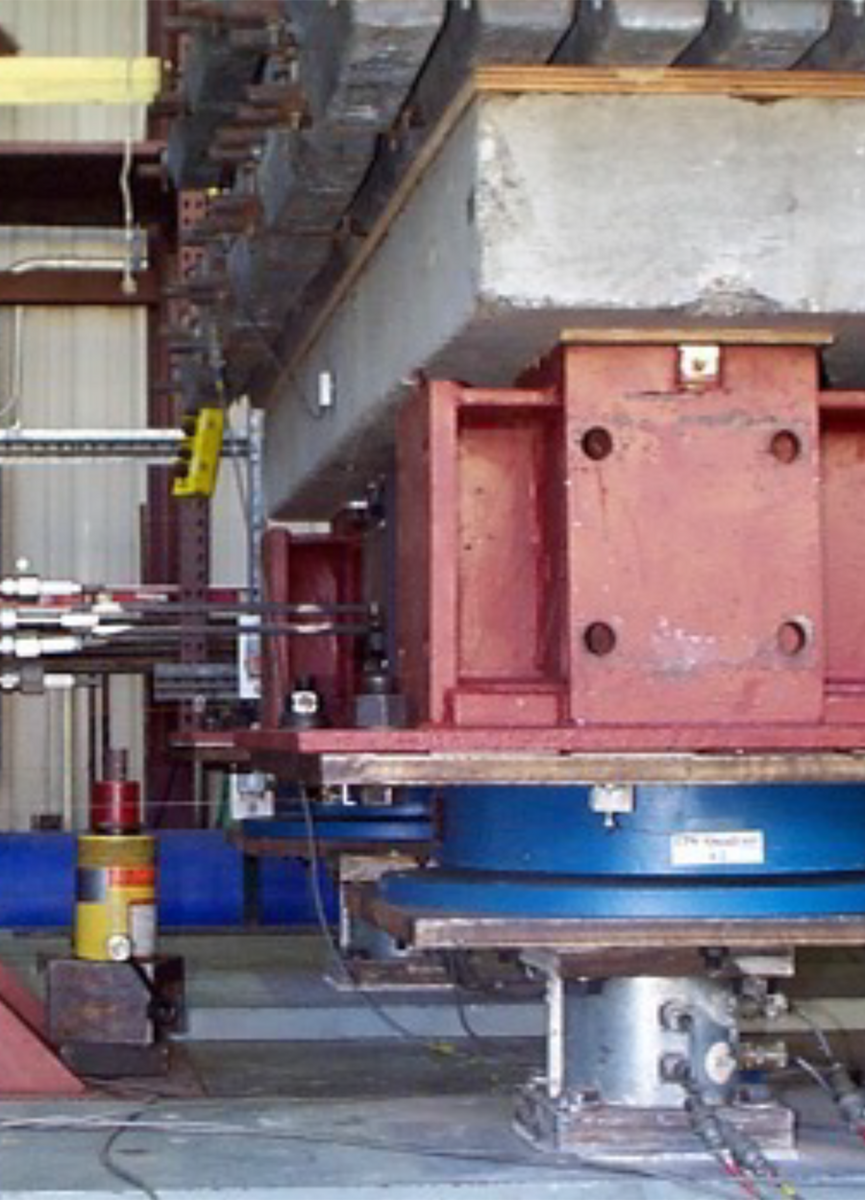
Shake table testing. Photo by Eduardo Miranda, Stanford University.
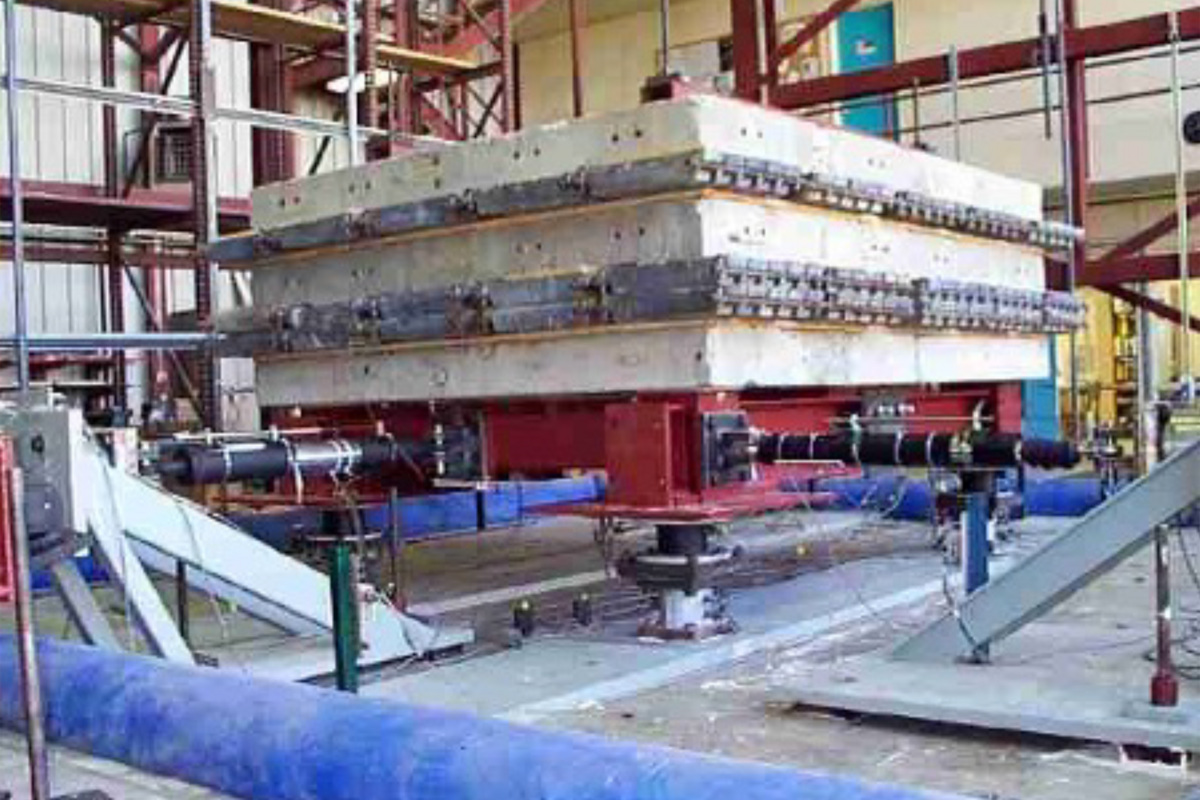
UC Berkeley-PEER Shake Table. Photo by Eduardo Miranda, Stanford University.

